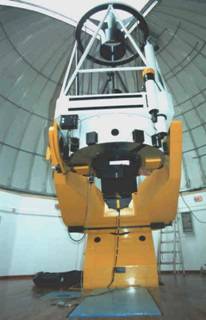Skinakas Observatory
 The favourable climatological conditions prevailing in Crete (large number of clear-sky nights per year) and laminal flow of air from the north of the island, combined with the high mountains, place the island of Crete among the best locations in Europe for high quality astronomical observations. These facts were influential in the establishment of Skinakas Observatory.
The favourable climatological conditions prevailing in Crete (large number of clear-sky nights per year) and laminal flow of air from the north of the island, combined with the high mountains, place the island of Crete among the best locations in Europe for high quality astronomical observations. These facts were influential in the establishment of Skinakas Observatory.
The Observatory was built as a scientific research collaboration between the University of Crete, the Foundation for Research and Technology-Hellas (FORTH) and the Max-Planck-Institut fur Extraterrestrische Physik of Germany. It currently operates under an MOU between the University of Crete and FORTH. The site of the Observatory, chosen on scientific and functional grounds, is the Skinakas summit of Mount Ida (Psiloritis), at an altitude of 1750 m and a distance of 50 km from Heraklion. The region belongs to the town of Anogeia, who donated an area of 15,000 m2, to the Univ. of Crete to build the Observatory, and has been supporting its operations in a number of practical matter as well as initiatives for its future development. Since 2018 the operation of Skinakas Observatory is managed by the Institute of Astrophysics - FORTH following an updated MOU between the University of Crete and FORTH.
 The Observatory has three telescopes: a Modified Ritchey-Chrétien telescope with a 1.3m aperture (focal ratio of F 7.6) a 0.6m robotic Cassegrain telescope and a 30cm wide field telescope (focal ratio F 3.2). The building for the smallest telescope was built in 1986, and regular observations started in 1987. The 1.3μ telescope commenced its observations in October 1995 and was the largest telescope in Greece until 2007. The optical system was manifactured by Carl Zeiss, and the mechanical parts by DFM Engineering. The 0.6m robotic telescope was installed on Skinakas in 2006 and operated until 2013 when, due to adverse weather conditions, the dome was damaged. A new building with a 5.3m diameter fast dome was built between 2020-21 and the 0.6m telescope became again operational in 2022. Details on the three telescopes are available here. Power to the site is provided by a photovoltaic station with backup generators.
The Observatory has three telescopes: a Modified Ritchey-Chrétien telescope with a 1.3m aperture (focal ratio of F 7.6) a 0.6m robotic Cassegrain telescope and a 30cm wide field telescope (focal ratio F 3.2). The building for the smallest telescope was built in 1986, and regular observations started in 1987. The 1.3μ telescope commenced its observations in October 1995 and was the largest telescope in Greece until 2007. The optical system was manifactured by Carl Zeiss, and the mechanical parts by DFM Engineering. The 0.6m robotic telescope was installed on Skinakas in 2006 and operated until 2013 when, due to adverse weather conditions, the dome was damaged. A new building with a 5.3m diameter fast dome was built between 2020-21 and the 0.6m telescope became again operational in 2022. Details on the three telescopes are available here. Power to the site is provided by a photovoltaic station with backup generators.
The current instrumentation of the 1.3m telescope includes:
- Focal Reducer which more than doubles the field of view of the telescope.
- autoguider
- three optical CCD cameras 2048x2048 pixels of 13.5 μm pixel size and an auxiliary CCD camera 3072x2048pixels with a 9μm pixel size
- a full set of narrow and broad-band photometric filters.
- a long slit spectrograph with a set of four slits of different size and 8 dispersion gratings.
- a specialized optical polarimeter (Robopol)
- a wide field near-infared camera (7' x 7') (currently not in operation)
Cunrently under construction is:
- WALOP: a high-efficiency, high-sensitivity, high-accuracy wide field optical polarimeter
The main ongoing astronomical projects at the Observatory of Skinakas include the study of:
- galaxies and Active Galactic Nuclei
- planetary nebulae
- supernovae remnants
- X-ray binaries (cataclysmic variables, accreting pulsars, black-hole binaries)
- polarization studies of blazars and of the magnetic field in molecular clouds of our Galaxy
For more information visit the dedicated web site of Skinakas Observatory.
- Department of Physics
- Education
- Personnel
- Sections
- Excellence
- Research News
- Publications
- Contact
- Announcements
- Colloquia
- Conferences
- Skinakas Observatory
- Institute of Theoretical and Computational Physics
- Crete Center for Theoretical Physics - CCTP
- Crete Center for Quantum Complexity and Nanotechnology - CCQCN
- Onassis Lectures
- International Prizes
- International Relations
- Computing Services
- Useful Links
- Visitor Information
